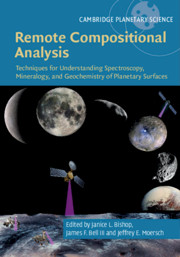 Remote Compositional Analysis
Remote Compositional Analysis from Part III - Analysis Methods
Published online by Cambridge University Press: 15 November 2019
The advent of multiple orbital and in situ missions to planetary bodies beyond Earth has enabled characterization of extraterrestrial shallow crustal processes. We describe examples of interpreting geochemical, isotopic, and radar properties from multiple remote datasets, supplemented with in situ observations from rovers and landers, meteorites, and lunar samples. Given the availability of distinct data types and the relevance to bulk-silicate bodies in the Solar System, we present five case studies for the Moon and Mars. The first involves lunar magmatic processes in relation to TiO2 and radargram-derived physical properties. Next, O and Fe isotope variations relative to the Mg number provide insight into the degree of fractional crystallization in lunar lava flows. Physical mixing of endmembers and chemical weathering processes in Gusev crater soil on Mars are discussed. Effective use of the Chemical Index of Alteration (CIA) is also considered by comparing mineralogic observations across Mars with terrestrial references. Lastly, the nature of bulk soil hydration on Mars is described by assessing chemical variations with Principal Component Analysis (PCA). This chapter describes in situ analyses and mapping across local and regional scales. Data synthesis also involves contrasting depth scales from tens of microns to multiple kilometers.
To save this book to your Kindle, first ensure [email protected] is added to your Approved Personal Document E-mail List under your Personal Document Settings on the Manage Your Content and Devices page of your Amazon account. Then enter the ‘name’ part of your Kindle email address below. Find out more about saving to your Kindle.
Note you can select to save to either the @free.kindle.com or @kindle.com variations. ‘@free.kindle.com’ emails are free but can only be saved to your device when it is connected to wi-fi. ‘@kindle.com’ emails can be delivered even when you are not connected to wi-fi, but note that service fees apply.
Find out more about the Kindle Personal Document Service.
To save content items to your account, please confirm that you agree to abide by our usage policies. If this is the first time you use this feature, you will be asked to authorise Cambridge Core to connect with your account. Find out more about saving content to Dropbox.
To save content items to your account, please confirm that you agree to abide by our usage policies. If this is the first time you use this feature, you will be asked to authorise Cambridge Core to connect with your account. Find out more about saving content to Google Drive.